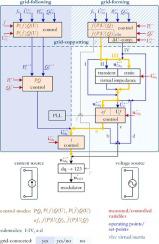当前位置:
X-MOL 学术
›
Int. J. Electr. Power Energy Sys.
›
论文详情
Our official English website, www.x-mol.net, welcomes your feedback! (Note: you will need to create a separate account there.)
Advanced classification of converter control concepts for integration in electrical power systems
International Journal of Electrical Power & Energy Systems ( IF 5.2 ) Pub Date : 2020-12-01 , DOI: 10.1016/j.ijepes.2020.106210 Stefan Henninger , Johann Jaeger
International Journal of Electrical Power & Energy Systems ( IF 5.2 ) Pub Date : 2020-12-01 , DOI: 10.1016/j.ijepes.2020.106210 Stefan Henninger , Johann Jaeger

|
Abstract As decarbonized power systems are mainly based on power electronic converters, the operational behavior of electrical power systems will be more and more determined by the control concepts of these converters. The wide variety of control concepts developed over the last years, however, often causes ambiguity and misunderstanding among power system experts regarding the performance of converters and converter-dominated power systems. Reviewing papers and classification schemes for converter control exist in great numbers but they do not cover the full range of control concepts or only deal with specific applications like microgrids. Therefore, this paper proposes an advanced classification that brings together different existing classification schemes, control concepts and control features and shows their interrelations in a new and comprehensive way. The proposed classification scheme combines four different criteria: the steady state equivalent circuit of the converter, the operating characteristic (grid-following, grid-forming, grid-supporting), different control modes (and submodes) regarding power, voltage and frequency and the ability/necessity to operate grid-connected. The control modes also include control features like virtual inertia or virtual impedances. Based on a double synchronous reference frame converter model, the different control concepts were presented by means of their control loops and equivalent circuits. The comparison with existing classification schemes and the application to different control concepts found in literature showed that the proposed classification scheme does not only provide a more detailed (submode-based) converter control classification but it also revealed new control concepts that were verified by simulation and experimental results. Thus, the control concepts for power electronic converters were reclassified, restructured and extended. In this way, the classification scheme proposed in this paper creates a proper basis for a comprehensive understanding of converters and converter-dominated power systems.
中文翻译:

用于电力系统集成的转换器控制概念的高级分类
摘要 由于脱碳电力系统主要基于电力电子转换器,电力系统的运行行为将越来越多地由这些转换器的控制概念决定。然而,过去几年开发的各种控制概念经常导致电力系统专家对转换器和转换器主导的电力系统的性能产生歧义和误解。有大量关于变流器控制的评论论文和分类方案,但它们并未涵盖所有控制概念或仅涉及微电网等特定应用。因此,本文提出了一种高级分类,将现有的不同分类方案汇集在一起,控制概念和控制特性,并以一种新的、全面的方式展示它们之间的相互关系。提出的分类方案结合了四个不同的标准:变流器的稳态等效电路、运行特性(并网、并网、并网),关于功率、电压和频率的不同控制模式(和子模式)以及并网运行的能力/必要性。控制模式还包括控制特性,如虚拟惯性或虚拟阻抗。基于双同步参考系转换器模型,通过控制回路和等效电路介绍了不同的控制概念。与现有分类方案的比较以及对文献中不同控制概念的应用表明,所提出的分类方案不仅提供了更详细的(基于子模式的)转换器控制分类,而且还揭示了通过仿真和验证的新控制概念。实验结果。因此,电力电子转换器的控制概念被重新分类、重组和扩展。这样,本文提出的分类方案为全面了解转换器和转换器主导的电力系统奠定了适当的基础。电力电子转换器的控制概念进行了重新分类、重组和扩展。这样,本文提出的分类方案为全面了解转换器和转换器主导的电力系统奠定了适当的基础。电力电子转换器的控制概念进行了重新分类、重组和扩展。这样,本文提出的分类方案为全面了解转换器和转换器主导的电力系统奠定了适当的基础。
更新日期:2020-12-01
中文翻译:

用于电力系统集成的转换器控制概念的高级分类
摘要 由于脱碳电力系统主要基于电力电子转换器,电力系统的运行行为将越来越多地由这些转换器的控制概念决定。然而,过去几年开发的各种控制概念经常导致电力系统专家对转换器和转换器主导的电力系统的性能产生歧义和误解。有大量关于变流器控制的评论论文和分类方案,但它们并未涵盖所有控制概念或仅涉及微电网等特定应用。因此,本文提出了一种高级分类,将现有的不同分类方案汇集在一起,控制概念和控制特性,并以一种新的、全面的方式展示它们之间的相互关系。提出的分类方案结合了四个不同的标准:变流器的稳态等效电路、运行特性(并网、并网、并网),关于功率、电压和频率的不同控制模式(和子模式)以及并网运行的能力/必要性。控制模式还包括控制特性,如虚拟惯性或虚拟阻抗。基于双同步参考系转换器模型,通过控制回路和等效电路介绍了不同的控制概念。与现有分类方案的比较以及对文献中不同控制概念的应用表明,所提出的分类方案不仅提供了更详细的(基于子模式的)转换器控制分类,而且还揭示了通过仿真和验证的新控制概念。实验结果。因此,电力电子转换器的控制概念被重新分类、重组和扩展。这样,本文提出的分类方案为全面了解转换器和转换器主导的电力系统奠定了适当的基础。电力电子转换器的控制概念进行了重新分类、重组和扩展。这样,本文提出的分类方案为全面了解转换器和转换器主导的电力系统奠定了适当的基础。电力电子转换器的控制概念进行了重新分类、重组和扩展。这样,本文提出的分类方案为全面了解转换器和转换器主导的电力系统奠定了适当的基础。


























 京公网安备 11010802027423号
京公网安备 11010802027423号